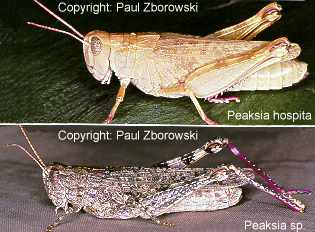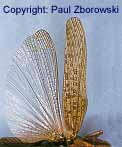Adult description 11 of 15


Size: Most species females 25 to 35-45 mm, males 20 to 25 mm.
Adult Description: Currently there are about 15 very hard to separate species. Colour is variable within and across species but usually brown to grey-brown with very fine 'salt and pepper' mottling. In profile head, thorax and wings are fairly level. The wings are the same length or slightly longer than the abdomen (most locusts have wings 1/4 to 1/3 longer). From above, the rear of the thorax comes to a point which is sometimes raised over the wing base as seen from the side. Most species are stocky, fatter than locusts. There is a throat peg but it is flattened to more of a mound shape with no point. Hind legs with strong dark bars across the femur with bright purple to red inner femur and tibia markings. Hind wings usually clear.
Confusion with Australian plague locust: Similar size. Peakesia hospita is sometimes found with the plague locust though most species of this genus prefer sandy country outside prime locust habitats (compare photos with Australian plague locust adult).
Confusion with Urnisa: Similar salt and pepper mottling and bright tibia colours but only Peakesia has a throat peg while Urnisa has a raised head and longer wing covers.Unique features: The combination of a stocky body with wings barely longer than the abdomen, bright purple inner rear tibia, general mottling all over the body rather than in a distinct pattern and a small throat peg, sets this genus apart.
Further information on this species: Description of nymph
